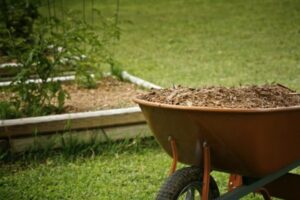15 Things About Garden Mulch You Need to Know (Yes, Really!)

What do you and your gardening friends chat about when you get together? Chances are that the topic of garden mulch comes up. I find that this ubiquitous garden tool comes with a lot of fiction but is short on fact. So, let me drop some knowledge on you about garden mulch:
Note: When it comes to mulch, gardeners have many (many!) options. This article will focus on only eco-friendly organic mulches.
1. There are many benefits to using mulch. These include: retaining soil moisture, adding organic matter to soil, lessening the impact of foot traffic, helping to maintain a constant soil moisture level (which helps with plant quality), and weed control. If you want your mulch to control weeds, be careful to choose the right type (more on that later in this post).
2. Chopped or shredded leaves make great mulch. Make sure to age the leaves for at least nine months before using in your garden. This allows for growth inhibiting phenols to leach out.
3. Straw can make a great mulch, but you must ensure that it is seed free. So, when you’re buying it, be sure to read the label carefully. Some gardeners use hay as mulch, but because it contains too many seeds, I avoid it.
4. Newspaper and cardboard are great mulches, but avoid glossy or colored ink. Because the newspaper is light it may blow away, so weigh it down with a few well placed rocks. Use two to three sheets of newspaper and one layer of cardboard.
5. Grass clippings are a great mulch, but there are a few caveats. First, make sure that the grass has not been treated with herbicide or pesticide. Second, let the clippings dry for one day before applying to your garden. And lastly, leave some of the grass clippings on your lawn too.
6. Compost is an excellent mulch. Having said that, I don’t usually use it as mulch because I like it mixed in with my soil under another type of mulch. Some mulches can deplete the soil of nitrogen so having a layer of compost under it is beneficial.
7. Organic wood or bark is a fine mulch, but some folks strongly disagree with me. They say that the wood can spread spores that become a nuisance. If you choose this type of mulch, don’t put it directly in your growing beds–use it to line garden pathways. Why? It takes too long to break down before it can be beneficial to the soil. Also, small chunks of wood are okay to use as mulch, but don’t use fine saw dust because it creates a carbon-nitrogen imbalance.
8. If you live near an ocean, like me, seaweed is a wonderful mulch! It’s my go-to mulch every spring. My dog and I spend a fun afternoon at the beach collecting seaweed. I love using it as a mulch because as it breaks down it will add vital minerals and nutrients to the garden soil. As an added benefit, it deters slugs. Some folks worry that its salt may harm soil, but I’ve never had a problem with this.
9. Another of my favorite mulches is comfrey leaves. Comfrey plants are easy to grow, and you can use their large leaves as a layer of mulch. As they break down they are a beneficial soil amendment.
10. Cocoa bean hulls are sometimes used as mulch. They’re great because they contain nitrogen, phosphate and potash which all benefit garden soil. They also have an attractive smell. However, if they get too wet they attract pests. Dog lovers be careful: Don’t use cocoa bean hulls because they are toxic to dogs (just like chocolate is toxic to them as well).
11. Plastic is a popular mulch but I avoid it. Why? It isn’t biodegradable. With so many other mulch options, I choose one that is more beneficial to my soil. Also, while it is a great weed barrier, it is also a moisture barrier. Particularly in very warm areas, it will suffocate your plants. I also avoid polyester garden fabrics, gravel, and stone. Again, they don’t benefit my soil as much as other options.
12. I use one to two inches of mulch in my garden. Some gardeners use as much as four to six inches. How much you use depends on how much you have and your soil conditions.
13. Apply mulch when seedlings are four to six inches tall.
14. Don’t mulch too early in the spring because you want to give the sun time to warm the soil.
15. Leave one inch around each plant’s stem free from mulch.
Related on Organic Authority
7 Reasons Your Garden Will Love Cocoa Mulch
6 Natural Weed Control Solutions For Your Lawn & Vegetable Garden
Benefits of Raising Chickens: Organic Weed and Pest Control
photo of wheelbarrow in garden via Shutterstock

